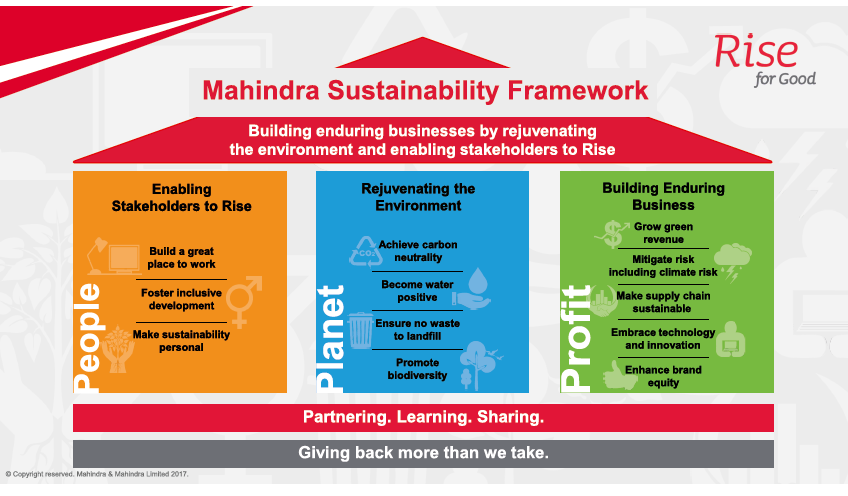- Resources
- Not investing in energy efficiency is a foolish thing to do, says Mahindra CSO
Resources
Not investing in energy efficiency is a foolish thing to do, says Mahindra CSO
Published: January 11, 2018 by Tom Murray
At Environmental Defense Fund, we believe that environmental progress and economic growth can and must go hand in hand. EDF+Business works with leading companies and investors to raise the bar for corporate sustainability leadership by setting aggressive, science-based goals; collaborating for scale across industries and global supply chains; and publicly supporting smart environmental safeguards.
This is the third in a series of interviews exploring trends in sustainability leadership as part of our effort to pave the way to a thriving economy and a healthy environment.
Anirban Ghosh has been at Mahindra since 1999, and in that time worked across the business, including sales, marketing, strategy, and new business development. He played a key role in Mahindra’s expansion into the agriculture business, led the implementation of award-winning shared value projects like watershed development, and applied a strategic approach to the company’s social investments.

Today, he is Chief Sustainability Officer of the India-based corporation and focused on driving positive environmental change for all stakeholders. Under Anirban’s leadership, Mahindra has set a greenhouse gas reduction target for the company’s farming and automotive divisions, started using an internal price on carbon, and publicly disclosed their climate risks and carbon emissions data across key business sectors.
I called Anirban a few weeks ago to talk about trends in sustainability leadership and what Mahindra is doing to combat climate change. I came away from our conversation inspired by Anirban’s insights, and am eager to see what the company does next.
Here’s an edited excerpt of our conversation.
What prompted you to change directions at Mahindra and focus on corporate sustainability?
Every time I was asked to write my resume, people would tell me to put the purpose of my life on the resume. And the only phrase that kept coming back to me was: make a difference. Somehow it didn’t sound corporate enough so I never did put it on my resume, but I was very fortunate to be working in industries that were indeed causing transformation.
For example, I began my career at Mahindra in the office automation industry when computers were brand new in India. Watching offices transform from the computers we sold to them was something that fascinated me.
When I worked in the agriculture division, we focused on enhancing farm mechanization and bringing prosperity to farmers — who constituted 70 percent of India’s population.
I then moved on to head our sustainability work because that’s where my natural tendencies were leading me.
I’m intrigued by the CSR law in India that requires companies to give 2 percent of their net profits to charitable causes. How has industry responded?
It’s been only three years but I think corporations are figuring out ways of using this money to make a real difference to society. I suppose one reason why people like me gravitate towards a corporation like Mahindra is because there is this ethos that we are driving positive change.
Mahindra has always believed in giving back, so for us this was a logical transition. Before the law was enacted, our chairman had pledged to give 1 percent of our profits to support CSR. When the regulation became official, we just changed our giving from 1 to 2 percent.
Are there efforts that have been funded by Mahindra through this law that you are particularly proud of?
One of our flagship programs is supporting the education of underprivileged girls in India. There are now more than 300,000 children who have benefited from the program.
Also, over the last 10 years we’ve planted 13 million trees. We realized that India was losing its tree cover, so we started to plant trees at a massive scale, with a survival rate of more than 70 percent. The impact it’s having is not just on the environment, but also on the livelihoods of communities where the trees are planted. Most of these trees are fruit trees that contribute income in those communities.
 Lastly I’ll mention our watershed development project. In India we have seen the per capita use of fresh water go down by 80 percent over the last 70 years but we also know that water scarcity is going to be a reality. In many places, it is a reality now and a threat to agriculture. So we worked with the government to harness water and enable agricultural productivity enhancements for the farmer. Over five years, we more than doubled household income for 20,000 Indians.
Lastly I’ll mention our watershed development project. In India we have seen the per capita use of fresh water go down by 80 percent over the last 70 years but we also know that water scarcity is going to be a reality. In many places, it is a reality now and a threat to agriculture. So we worked with the government to harness water and enable agricultural productivity enhancements for the farmer. Over five years, we more than doubled household income for 20,000 Indians.
At EDF we’re focused on climate change and think it’s the biggest environmental and economic challenge and opportunity of our time. I know this is a focus for you at Mahindra. Can you explain the process of developing your emissions reductions goals?
It started with someone asking us the question: do you have a triple bottom line report? An internal investigation to answer this question led to the development of what we call the Mahindra Sustainability Framework which captures our core areas of work on sustainability.
During the framework development process, there was a lot of advocacy required within the organization to help managers get a wider understanding of what sustainability really means. Now, we have the Sustainability Council, where leaders from different businesses across the Mahindra Group are engaged in sustainability discussions.
One of our most exciting programs is called Making Sustainability Personal. Through this program, we engage colleagues at all levels and locations to take actions which help them contribute to the fight against climate change. One example would be to adopt LED lighting in their own homes, but it also leads to the organization as a whole contributing to conservation not just leadership or the sustainability department.
 What are the reasons for bringing in an NGO partner to help in developing your emissions reduction goals?
What are the reasons for bringing in an NGO partner to help in developing your emissions reduction goals?
The first realization we had as we started setting goals is that we didn’t really know how to go about achieving those goals because we were not subject matter experts in the area.
We were quite happy to engage with NGOs like EDF to understand the subject better and figure out ways by which we could solve climate change-related problems and adapt to climate change.
What are some of the business benefits you’ve seen from sustainability?
Every dollar that we invest in energy efficiency gives us returns in excess of 25 percent, which often is higher than the investments we make in new products. Therefore, not investing in energy efficiency today seems to be a foolish thing to do.
Every extra dollar we can spare for every new technology that enables us to be more energy efficient is well invested. This is why we were actually quite happy to look at a carbon price on the business because it brought discipline into investing in technologies that help reduce our carbon footprint.
Some examples of how we invest are:
- Micro-irrigation: We know 70-80 percent of fresh water is used for irrigation and agriculture, therefore any technology that helps to optimize water use is a great investment.
- Electric vehicles: We know that the best way forward is to move to electric vehicles.
- Green construction: About 40 percent of emissions comes from buildings and the only way to reduce that is to construct buildings that are energy efficient.
- Solar power: We all know that we will move from coal-based energy to solar power, so we invested in a business that erects solar powered generating stations for clients.
- Recycling old vehicles: Over time, we know that old vehicles on the street will need to be recycled responsibly, so we’re actively involved in this area it’s one of our newest businesses.
I’ve read some of your recent writing and you believe we are in the midst of a revolution that will make technology more effective, more accessible, and more affordable to solve sustainability challenges. EDF is very focused on that as well, and we’re calling it the Fourth Wave of environmental innovation. How do you see technology driving these solutions?
Let’s contrast how two technologies are being adopted today: LED lamps and electric vehicles (EVs). We know both of them are very good yet you don’t really have to work hard to get somebody to buy LED lamps. With electric cars, you still have to work very hard to get somebody to buy it. And that’s essentially because LEDs in the course of their journey have, apart from being effective, become accessible and affordable.
We always knew that LEDs give us more light for unit of power consumed, but it was not always affordable and not always accessible. But because of the program that India ran over the last two-three years, LEDs are now available to everybody.
The complete contrast is electric vehicles. We manufacture them, we offer them to our employees and my colleagues, and yet there aren’t too many takers because even though it’s reasonably effective, they’re far too expensive to become mainstream. So there is no explosion in the adoption of EVs yet.
This contrast clearly shows that when a technology which is effective becomes both accessible and affordable, the adoption goes through the roof. And we know that to fight climate change certain technologies have to become mainstream.
So whether it is energy storage, renewable energy, or recycling waste, corporations like ours need to clear roads either in making these technologies reach a stage where they become mainstream or adopting these technologies so that those who are driving the technologies have an opportunity to make it go mainstream.
How does your partnership with Ford fit in with Mahindra’s plans for transitioning away from gas powered vehicles?
We know that within another decade or so electric vehicles will be more affordable than vehicles with internal combustion engines. If we don’t invest in them now, a large part of our business which depends on vehicles using internal combustion engines may well become defunct. So there is a very strong economic reason for us to invest in EVs and partner with Ford.
We also acquired Pininfarina, the Italian design company. We believe that the Ford and Pininfarina partnerships will help us find a solution in electric vehicles which will be attractive to the consumer in India and abroad.
Mahindra has a subsidiary called Susten, which is one of India’s largest distributed and utility scale solar provider. How do you see solar advancing in India?
India has committed to making 40 percent of its electrical energy come from renewable sources, under the United Nations Framework Convention on Climate Change. It is expected that by 2025 or 2026 the cost of solar plus storage will be lower than the cost of getting power from thermal stations which means solar will play a large role in helping to meet our commitment.
Mahindra Susten has competed in the reverse auctions that the government holds in India for very large projects (an auction approach to procurement where a buyer a solar energy installer in this case receives bids) and hopes to help the country achieve the 40 percent goal that it set for itself by 2030.
I have saved my most challenging question for last. I understand that you are fan of cricket and tennis. What’s more fun to watch: the Cricket World Cup or a Grand Slam tennis tournament?
I really don’t want to be in a situation where I have to choose between watching a match between Federer and Nadal versus watching India and some other country playing the Cricket World Cup. That would be a very hard choice, Tom.
Follow Tom on Twitter, @tpmurray
